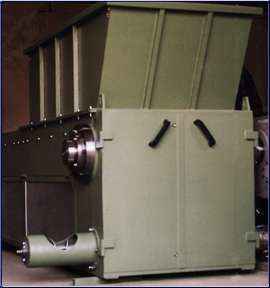|
Plastic ShreddersCritics of Saddam Hussein's regime have produced new evidence of his brutality. Ann Clwyd is a member of British parliament and head of the Indict organization which gathers information about war crimes. She cites an Iraqi woman's description of Saddam's use of plastic shredders. The full text of her lurid claim was eagerly shared among journalists and weblog operators for several days during the start of Operation Iraqi Freedom, and then—for whatever reason —summarily abandoned.
This "shredding" of human beings deserves closer attention. What exactly is a plastic shredder, and how does it work? Plastic recycling is actually a very big business. Companies like Shred-Tech, Accu-Grind, Destroyit, and the Cutter Corporation specialize in what industry professionals romantically refer to as reduction-pulverizing engineering.
Shredding technology has made substantial advancements since the early 1990s. Shredders of enormous size and horsepower are readily available worldwide. Shredder shaft speeds and knife tip forces are power words used by insiders to determine what a given piece of machinery is capable of. Aluminum, electronic scraps, automotive materials, textiles, Iraqis—you name it and someone wants to get rid of it. Shredding machines exist for two principal reasons: volume reduction and complete destruction. If your shredder is large enough, your regime alone might be able to recycle sixty million pounds of material per year. In order to get the right machine for a specific operation (humane or otherwise), both the user and the supplier need a clear understanding of the intended application. Because shredders are used for so many different products, it's essential that the operator first consider his current and future processing goals. When buying a shredder, first ask if it will be fed with a conveyor belt or a dumper, and what types of materials are to be recycled. Both parties need to know the size, shape, material properties, and form of the items to be processed.
|
 "There was a machine designed for shredding plastic," she told the group. "Men
were dropped into it, and we were made to watch. Sometimes they went in head
first and died quickly. Sometimes they went in feet first and died screaming.
It was horrible. I saw thirty people die like this. Their remains would be placed
in plastic bags and we were told they would be used as fish food. On one occasion,
I saw Quesay (a son of Saddam) personally supervise these murders."
"There was a machine designed for shredding plastic," she told the group. "Men
were dropped into it, and we were made to watch. Sometimes they went in head
first and died quickly. Sometimes they went in feet first and died screaming.
It was horrible. I saw thirty people die like this. Their remains would be placed
in plastic bags and we were told they would be used as fish food. On one occasion,
I saw Quesay (a son of Saddam) personally supervise these murders." A
typical shredder consists of a large entry bin, called the hopper. Directly
below the hopper lays a vast array of rotating shredding knives (nicknamed grizzlies),
streamlined for increased torque and optimized for granulation. These are not
desktop paper shredders intended for the disposal of your resumé.
A
typical shredder consists of a large entry bin, called the hopper. Directly
below the hopper lays a vast array of rotating shredding knives (nicknamed grizzlies),
streamlined for increased torque and optimized for granulation. These are not
desktop paper shredders intended for the disposal of your resumé.  The
entire operation of a plastic-shredding recycling center is controlled and monitored,
particularly at the crucial points: trailer dump areas, conveyor flow, sorting
areas, the baler's compacting chamber, and bale loading stations. By means of
closed-circuit television located in a control room (overlooking the trailer
dumpers and above the initial sorting area where the trailer loads are dumped)
the control-room operator can oversee all the dumping with a full view of the
sorting area on multiple screens. It's unknown at the time of this reporting
if Saddam regularly complies with hardhat and eye-protection safety guidelines.
The
entire operation of a plastic-shredding recycling center is controlled and monitored,
particularly at the crucial points: trailer dump areas, conveyor flow, sorting
areas, the baler's compacting chamber, and bale loading stations. By means of
closed-circuit television located in a control room (overlooking the trailer
dumpers and above the initial sorting area where the trailer loads are dumped)
the control-room operator can oversee all the dumping with a full view of the
sorting area on multiple screens. It's unknown at the time of this reporting
if Saddam regularly complies with hardhat and eye-protection safety guidelines.